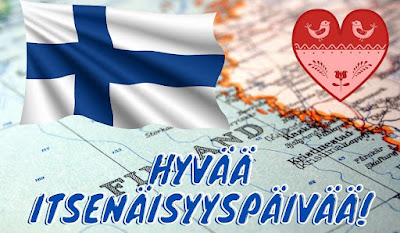Finland is a country in northern Europe, in the region of the Nordic countries that also includes Iceland, Denmark, Sweden and Norway. It borders Russia to the east, Norway to the north and Sweden to the northwest. In the southwest of the country is the Baltic Sea.
From the Middle Ages to the early 19th century, Finland was part of Sweden. In 1809 the Russian Tsar Alexander I conquered Finland from Sweden and annexed it to the Russian Empire as "Grand Duchy".
Russian rule lasted until Imperial Russia underwent the October Revolution of 1917 which brought an end to Tsarist rule. Finland saw its opportunity to negotiate sovereign independence and the Finnish parliament declared its independence on December 6 of that year.
In Finnish, Finland's name is Suomi. The name Finland originates from the Swedish language that has been the prevailing language in the country since Sweden's invasion of it in the 12th century.
The climate of Finland is characterized by cold temperatures of the Arctic region. The Baltic Sea and its many lakes moderate the cold a bit. The country is mostly flat, with small hills and its surface is low.
Finland is home to about 5.5 million people, as of February 2021. The capital of Finland is Helsinki.
Finland's Independence Day is celebrated on December 6 every year. This is a very patriotic day because on this day the independence of the country declared on this date in 1917 is respected, as well as the events of World War II in which Finland almost lost its independence again.
How do you celebrate Finnish Independence Day?
Independence Day was first celebrated in 1919. Initially Independence Day was a festive event with patriotic speeches and special church services.
Recently, the Independence Day celebration has become a more lively event and Finns have five special traditions for celebrating this day:
Candles - The Finns place special candles in blue and white, the flag colors, usually two, near the window. This tradition began in the 19th century and is said to be reminiscent of the period when two candles were placed in a window as a sign to Finnish soldiers that the house would offer them shelter and hide them from the Russians.
2. War graves - Many Finns visit the cemetery and light candles so that the whole area sparkles beautifully. In all the big and small cities, war graves and memorial stones are visited by city officials and sometimes there is a candle parade of students or children, which pays homage to the graves.
3. Watch the 2017 film Tuntematon sotilas (The Unknown Soldier), directed by Aku Louhimies, based on a novel by Väinö Linna, which depicts World War II in Finland.
4. Blue and white - The blue and white colors of the Finnish flag are proudly displayed in shop windows and bakeries that make cakes with a blue and white icing.
On Independence Day there are no special dishes, but most people have a more fancy dinner. Many bake gingerbread or tart and plum tart cookies which are seasonal treats especially before Christmas.
5. Watching the reception for Presidential Independence Day. At 19:00, the official Independence Day celebration begins with a Gala (‘Linnan juhlat‘ ) at the Presidential Castle in Helsinki, which is televised.
Some interesting trivia facts about Finland
Finland has 179,888 islands and 187,888 lakes.
The only common English word taken directly from Finnish is 'sauna'.
There are more saunas than cars in Finland. It is estimated that there are 2,000,000 saunas in Finland, for a population of 5.3 million!
Finland is sometimes mistakenly included as part of the Scandinavian region. This is not true because Scandinavia is a geographical area that includes only Sweden, Denmark and Norway. Finland belongs to the Nordic countries and the correct term for the territory that includes Scandinavia and Finland is Fennoscandia.
If you want to visit Finland, the cheapest month to visit it is July and the most expensive is January.
Northern Finland is part of a region called Lapland.
If you want to watch the Northern Lights in Finland, you should visit the village of Luosto, located north of the Arctic Circle in Finland, between September and March.
Happy Independence Day Finland - Hyvää itsenäisyyspäivää!
 |
| Happy Independence Day Finland - Hyvää itsenäisyyspäivää! |
December 6 is also Miners Day and Constitution Day in Spain


































